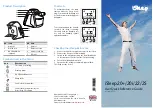
NEO IP/GSM Technical Handbook
Document number: NE41 09002-02 v2.0
3 The alarm call
3.1 Call structure
The reason for the alarm i.e. the alarm source decides what alarm type that will
be used in the alarm call. The alarm type forms a part of a group which points
to a call sequence. The sequence consists of up to 4 call types with telephone
number, alarm code, protocol and number of call attempts.
3.2 Alarm events
An alarm can be initiated by one of the following reasons:
• A radio signal from a radio transmitter, e.g. ATOM
• A push on the alarm button or extra button
• An internally activated alarm
Depending on the alarm event, the alarm can be routed to different alarm receiv
-
ers in sequence. The type of alarm event is called alarm type, see next section.
3.3 Alarm types
3.3.1
Radio equipment alarms
When an alarm arrives from a radio transmitter, the alarm type is normally decid
-
ed from what alarm type that is connected to the radio position. If e.g. an ATOM
is programmed into radio position 1, the alarm type is decided from the listbox.
To determine the alarm type for a given radio transmitter, see 8.7.1 Radio alarms
Alarms from alarm button or extra button
When the user presses the alarm button, the alarm type will always be
User
alarm from button
.
The extra button can be programmed to send desired alarm type. Please note
that
Presence alarm
and
Passive alarm
will activate special functions, see sec
-
tion 6.3 and 6.6.
To determine the alarm type when pressing the grey
Extra button
3.3.2
Internally activated alarms
The following alarms are activated internally.
•
Reminder alarm
•
Passive alarm
• Automatic ready indication
•
Test alarm
•
Mains failure alarm
• Mains OK indication
•
Accumulator alarm
•
Radio interference alarm
The alarm call
18 of 56
















































